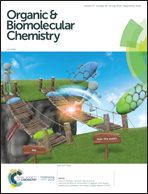Identification of HSP90 as a direct target of artemisinin for its anti-inflammatory activity via quantitative chemical proteomics†
Abstract
The anti-malarial drug artemisinin (ART) possesses potent anti-inflammatory activity, yet its underlying mechanism of action has remained elusive. Here we employed quantitative chemical proteomics to in situ profile the cellular targets of ART and identified heat shock protein 90 (HSP90) as a direct target. Further study revealed that ART suppressed the production of nitric oxide (NO) in macrophages via inhibiting the interaction between HSP90 and inducible NO synthase (iNOS).

- This article is part of the themed collection: Chemical Biology in OBC


 Please wait while we load your content...
Please wait while we load your content...